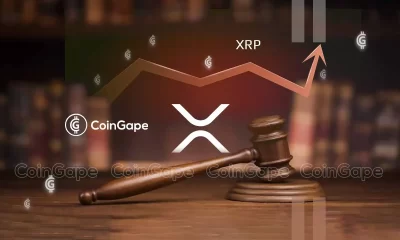business
Scandal-Rocked Energy Firm Enron Relaunches—With a Potential Crypto Twist
Published
1 month agoon
By
admin

Enron—yes, that Enron—announced on Monday that it has relaunched to “solv[e] the global energy crisis” with the aid of decentralized technology, some 23 years after the firm collapsed in what was then the greatest corporate fraud scandal in American history.
“With a bold new vision, Enron will leverage cutting-edge technology, human ingenuity, and the spirit of adaptation to address the critical challenges of energy sustainability, accessibility, and affordability,” the newly reformed company said in a statement today.
Enron has not yet offered much in the way of specifics regarding what exactly it plans to achieve, and how—but the firm says “permissionless innovation” will be a cornerstone of its approach, and that it plans to play a key role in the advancement of “decentralized technology.”
An Enron spokesperson declined comment when asked how exactly crypto might be well-suited to accomplishing the company’s new goals, and whether it has plans to work with any specific blockchains.
The most tangible information provided by the company today alluded to its plans to invest in renewable energy infrastructure, energy storage, and advanced power distribution systems.
Enron once ranked among America’s largest energy companies, until a 2001 scandal revealed the company to have hid billions of dollars in debt through systemic fraudulent accounting practices. Enron’s ensuing multi-billion bankruptcy—plus the criminal charges levied against many members of its leadership—made the company’s name synonymous with corporate fraud.
Now, that name is being dusted off for the first time in decades, to achieve as-of-yet murky plans in the intersection of energy and crypto.
Enron did acknowledge the elephant in the room on Monday, asserting that “ethical business practices” will be a key feature of its reincarnation. The company also plans to demonstrate a “renewed commitment to integrity” and “forgiveness.”
As far removed as Enron might seem from the world of crypto, the company’s undoing did resurface in late 2022, when industry leaders compared it to the then-unfolding collapse of FTX.
The bankruptcies of both now-infamous firms were overseen by the same executive, John J. Ray III, who said at the time that FTX’s misdeeds were—even compared to Enron’s—“unprecedented.”
Maybe that’s an alluring prospect for Enron’s new leaders, then: crypto’s the one industry that’s already, somehow, seen worse.
Edited by Andrew Hayward
Daily Debrief Newsletter
Start every day with the top news stories right now, plus original features, a podcast, videos and more.
Source link
You may like


Why You May Want To Redeem Your Bitcoin From THORChain's Lending Service


Zuckerberg Knowingly Used Pirated Data to Train Meta AI, Authors Allege


Meme Index raises $2M in 2 weeks


XRP Price Eyes Breakout: Bullish Pennant Points Upward


Pieter Wuille and Gregory Maxwell Receive The Finney Freedom Prize


Kenya Prepares to Legalize Cryptocurrencies in Policy Shift: Report
Bitcoin
Ledn Remains Bitcoin’s Premier Borrowing And Lending Platform
Published
2 days agoon
January 8, 2025By
admin

Company Name: Ledn
Founders: Mauricio Di Bartolomeo and Adam Reeds
Date Founded: September 2018
Location of Headquarters: N/A (Fully remote)
Number of Employees: 51
Website: https://ledn.io/
Public or Private? Private
“Lending is the type of relationship where you value the return of your assets more than the return on your assets.”
This was Di Bartolomeo’s answer when I asked him what has set Ledn, a bitcoin and crypto borrowing and lending platform, apart from its competitors, including now defunct companies that offered similar services like BlockFi, Celsius and Voyager.
“There’s no company in this space that has a better track record of returning your assets than Ledn,” Di Bartolomeo told Bitcoin Magazine.
Since its founding, Ledn has prioritized security and reliability. Di Bartolomeo and his co-founder, Adam Reeds, have not only wanted to win the trust of the traditional financial institutions with which Ledn interfaces but that of Ledn’s global user base, some of whom are accessing financial services for the first time thanks to the company.
And Di Bartolomeo’s work is quite personal to him in part because he understands the importance of Bitcoin thanks to his firsthand experience with it in his home country of Venezuela.
Di Bartolomeo’s Bitcoin Journey
“My family found Bitcoin and started mining it in Venezuela in late 2014/early 2015 in the middle of hyperinflation where basically it was illegal for them to buy or hold U.S. dollars or anything that would preserve value,” recounted Di Bartolomeo.
“When I saw how they and other Venezuelans were using Bitcoin to opt out of their broken system, I thought to myself “How many people in the world live like this and how many people in the world are going to need this?” And my answer was a number that I couldn’t compute in my head,” he added.
Di Bartolomeo decided to begin working in the Bitcoin space soon after. He moved to Canada where he and Reeds began helping miners grow their operations. Di Bartolomeo recalled that these miners wanted to expand but didn’t want to sell their bitcoin to do so.
“They had bitcoin revenues and fiat expenses, and there was no real place for them to get any type of financing,” said Di Bartolomeo.
“We sought financing, but nobody would give us a loan. So, we decided to solve our own problem,” he added.
“That was the genesis of Ledn.”
How Ledn Differentiated Itself
When Ledn was founded in 2018, only a few other services like it existed. However, there was a notable difference between Ledn and its competitors.
“There were other bitcoin-backed lenders in the market, but they required tokens,” said Di Bartolomeo.
“This was around the ICO era and we saw Nexo and Celsius come into the space with tokens. My view was that they were only using them to raise cash without selling off equity,” he added.
Di Bartolomeo and Reeds didn’t want to issue a token, as they saw it as a questionable practice from a regulatory perspective.
“When you look at finance at scale, immediately you think about compliance and regulation,” said Di Bartolomeo. “We wanted to build a company that was able to sit in front of BlackRock or Goldman Sachs, heavily regulated banks, and say, ‘Hey, I want to interact with you guys.’”
What is more, Ledn also prioritized transparency. In 2021, it became one of the first major Bitcoin companies to issue a proof of reserves, a system that allows anyone to audit Ledn’s bitcoin holdings.
“We’re still the only lender operating in the U.S. or other highly-regulated markets that has this proof of reserves where every six months our clients can come and check it out,” said Di Bartolomeo. “We’ve been doing this since before it was cool.”
Ledn also publishes a monthly Open Book Report that breaks down Ledn’s lending strategies.
From early on, Di Bartolomeo believed that taking a buttoned-up and transparent approach would foster trust amongst Bitcoin enthusiasts, a group that lives by the “don’t trust, verify” mantra, and his thesis has played out.
Reducing Risks
Of the many products Ledn offers, one is yield generation on bitcoin — the same type of product that caused the demise of BlockFi.
However, Ledn approaches its version of this product differently than its former competitor did.
“We generate Bitcoin yield on bitcoin primarily by lending it to market makers that arbitrage the BlockRock IBIT ETF and units of Coinbase spot,” said Di Bartolomeo.
“These groups are price neutral. They don’t have directional exposure. They’re just closing price gaps and benefitting from volatility,” he added.
BlockFi’s approach was far riskier.
“With BlockFi, there was a duration mismatch,” explained Di Bartolomeo.
“They were taking open-term deposits, and they were deploying them into mining infrastructure that had five-year payback. What do you think is going to happen when somebody shows up before the five years are done?” he added, alluding to the notion that what happened to BlockFi seemed inevitable.
What is more, Ledn only deals in highly liquid assets like bitcoin (and ether, which they added in 2023), which helps alleviate asset liability mismatch risk.
“With bitcoin, you always have people on both sides of the house with demand,” said Di Bartolomeo.
“When you start supporting things like Shiba Inu or Dogecoin and people want to earn interest on those, you then have to turn that Dogecoin into something else, and you create asset liability mismatch in the process,” he added.
Di Bartolomeo also noted that all of Ledn’s products are ring-fenced from one another.
“When you’re paying for a custody loan, you are not exposed to the credit risk of our other products,” he said. “This is very similar to how traditional finance works, and it’s something we do very differently as compared to our now defunct peers.”
Growing Competition
As more people begin to view bitcoin as “pristine collateral,” more bitcoin borrowing and lending platforms are destined to pop up. Many already have.
Centralized bitcoin borrowing and lending services like Salt and Nexo remain competitors to Ledn, while institutional bitcoin financing services like Newmarket Capital’s Battery Finance are also poised to cut into Ledn’s business. And services that enable users to borrow against their bitcoin in a non-custodial manner, including Debifi and Lava, may also increase their market share.
Di Bartolomeo is aware of the competition but doesn’t seem concerned. In fact, he believes that in such a market, the biggest winner will be the consumer, and he doesn’t have any plans to change Ledn’s strategy. Instead, he’s looking to double down on what Ledn does best.
“Our sweet spot is going to be individuals or people who prioritize transparency, security of funds and compliance,” said Di Bartolomeo.
“Safety, trust and transparency are what makes Ledn stand out. There is no other operator like us in this space with an equivalent track record as far as loans processed, years in the business and cycles survived,” he added.
“This industry is volatile. You have to have the right expertise and the right set of values powering your team, and I think other companies would be hard pressed to demonstrate what we have over the time that we have. Will you be able to find something cheaper? Yes. Will that be riskier? Absolutely.”
Fostering Financial Inclusion
One of the primary ways in which Ledn differs from traditional borrowing and lending platforms is that its rates don’t differ based on the jurisdiction in which the lender or borrower is located.
“This makes people feel very empowered because they know that whether they’re in Madrid or Medellín, they’re getting the same rate,” said Di Bartolomeo.
And Di Bartolomeo smiled from ear to ear as he discussed this point, as it seemed to remind him of why he got involved with Bitcoin in the first place.
“This is one of the things that makes me proudest about this business,” he said.
“We have people back in Latin America who’ve come to us to say we are the first loan they’ve ever been approved for. This is because all we look at is ‘Did you complete KYC?’; ‘Are you a compliant citizen?’; ‘Do you have Bitcoin?,’” he added.
“It’s not ‘Where do you live?’; ‘Who are your parents?’; What’s your skin color?’ I love this aspect of Bitcoin and what we do.”
Source link
business
The ‘MicroStrategy of Dogecoin’ Launches DOGE Yield Strategy, Eyes Bitcoin and Solana Expansion
Published
6 days agoon
January 5, 2025By
admin

A firm that has adapted MicroStrategy’s Bitcoin reserve strategy with the meme coin Dogecoin has revealed plans to earn yield on its DOGE coins, with future ambitions to potentially offer products based on other major cryptocurrencies as investors look for new ways to get higher returns on their tokens.
Canadian investment firm Spirit Blockchain Capital said Thursday in a statement it intends to leverage its Dogecoin holdings through the new yield-generating strategy. The publicly traded company said the move will enable it to deliver value to its shareholders, in addition to expanding its treasury efficiency and enhancing the decentralized financial product adoption.
The initiative will serve as the bedrock for the company to launch potential yield-bearing strategies for other assets such as Bitcoin, Ethereum, Tether and Solana in the future, Spirit CEO Lewis Bateman said in a statement.
“We aim to unlock a previously untapped revenue stream while simultaneously positioning ourselves as a market leader in yield generation for not only Dogecoin, but the broader digital asset space,” Bateman said.
How exactly the company plans to generate yield on its DOGE treasury is unclear, however, and the firm did not respond to Decrypt’s requests for comment. Spirit Blockchain Capital did not announce an exact date for its yield-bearing strategy’s rollout.
The company’s announcement comes a few months after it acquired Dogecoin Holdings, a firm that is amassing DOGE as a treasury reserve asset. Spirit previously declined to disclose the size of its Dogecoin treasury to Decrypt, citing regulatory guidelines for its acquisition.
Yield-bearing financial instruments such as stablecoins have gained steam during this latest crypto market rally, with several major companies rolling out new tokens in recent months to meet sky-high investor demand.
Crypto investors can also earn yield on assets through such measures as staking—or locking up assets within a proof-of-stake network to earn interest-like token rewards—or pledging assets to crypto lending services.
Edited by Andrew Hayward
Daily Debrief Newsletter
Start every day with the top news stories right now, plus original features, a podcast, videos and more.
Source link
business
Crypto Crystal Ball 2025: Will VCs Go Crypto Crazy Again?
Published
1 week agoon
January 1, 2025By
admin

Among other things, 2024 saw an undeniable glow-up for the crypto industry, both in terms of market strength and political reputation. Now other sectors are once again taking note, setting up what could either be a rehash of 2021’s crypto bull market, or something else entirely.
At the end of every year, Decrypt looks into its Crypto Crystal Ball to augur the narratives likely to shape the coming year, and how they’re likely to impact you.
After examining Donald Trump’s crypto agenda and the odds that an upcoming Ethereum update could finally bring about mass adoption, here’s a look at how crypto’s relationship with venture capital is poised to change in 2025—and what shift could mean.
Back in 2021, crypto was the belle of the VC ball. But as soon as the digital assets market crashed, our novel industry suddenly became persona non grata on Wall Street and in the Bay Area. Any mention of crypto or NFTs was scrubbed from project pitch decks like the Black Plague.
Now that crypto prices are finally soaring again, it looks like venture capitalists are already trying to get back together with blockchain devs—and pretend the break-up never happened.
Both VC giant Andreessen Horowitz and famed Silicon Valley startup incubator Y Combinator announced in December that they are once again eagerly seeking to back crypto-related projects in 2025.
Of particular interest are projects related to stablecoins. Luke Gebb, the head of American Express’ Digital Labs division, told Decrypt that 2025 “will mark a pivotal year for the stablecoin industry” that could “transform the payments landscape.” Indeed, Y Combinator is specifically seeking stablecoin-related startups.
Why the sudden turnaround? Turner Novak, a tech-focused venture capitalist, thinks the answer is brutally simple.
“VCs chase momentum,” Novak told Decrypt. “They will always be back if prices are going up.”
But should crypto be so quick to take VCs back, years after being dumped?
Alexander Lin, a blockchain-focused investor at Reforge, is adamant that the industry should resist the impulse. As Lin sees it, the lesson of the last bull cycle was that venture firms dumped billions of dollars into worthless crypto projects to turn a quick buck, and the industry suffered immensely as a result.
“They invested in dogshit projects, founders that had misaligned incentives, and projects that had the sole priority of launching a token quickly,” Lin told Decrypt.
It makes sense why, Lin said. Investing in such projects allowed venture firms to dodge waiting years for an acquisition or IPO to make a profit. If these firms got in early to a crypto project, hyped it up, and then got out shortly after a token launch, it didn’t matter if the token—and the project—crashed months later. The gambit was successful on the VC’s balance sheet.
If traditional VCs have learned one thing from the last crypto bull cycle, Lin said, it won’t be to invest in durable blockchain companies that will grow over time; it will be instead, to get in even earlier to speculation-fueled projects.
Lin thinks that cycle, if repeated, could be detrimental to crypto’s long-term prospects. To prevent such an outcome, he says it’s essential for crypto projects to reject investors looking to wet their beaks on crypto’s current $3 trillion market cap; he said, instead, projects should only partner with backers focused on growing crypto to a $20 trillion market cap.
“You don’t get there by investing in meme coins, that’s for sure,” Lin said. “You get there by investing in foundational infrastructure companies.”
Daily Debrief Newsletter
Start every day with the top news stories right now, plus original features, a podcast, videos and more.
Source link

Why You May Want To Redeem Your Bitcoin From THORChain's Lending Service
Zuckerberg Knowingly Used Pirated Data to Train Meta AI, Authors Allege
Meme Index raises $2M in 2 weeks
XRP Price Eyes Breakout: Bullish Pennant Points Upward
Pieter Wuille and Gregory Maxwell Receive The Finney Freedom Prize
Kenya Prepares to Legalize Cryptocurrencies in Policy Shift: Report
Genius Group buys $5m more in Bitcoin, totaling treasury to $35m
Why This AI Agent Crypto AIXBT is Up 55% Today?
Have Bitcoin ETFs Lived Up to the Hype?
Apostas basquete Brasil
SAFE rallies 20% on Bithumb listing
Solana, XRP, Litecoin, HBAR in 2025 With New SEC Chair?
Bitcoin Supercycle Incoming Amid Changing Market Conditions, According to Alex Krüger – But There’s a Catch
K-pop giant Cube Entertainment’s CEO under fire for misleading crypto investment guarantees
How a Crypto Trader Turned a 90% Loss Into a $2.5M Win?

Ethereum’s lowered yield might signal a paradigmatic shift in the ecosystem

Telegram users can send gifts to friends, TON fails to pump

Institutional Investors Go All In on Crypto as 57% Plan to Boost Allocations as Bull Run Heats Up, Sygnum Survey Reveals

Arthur Hayes, Murad’s Prediction For Meme Coins, AI & DeFi Coins For 2025

Bitcoin Could Rally to $80,000 on the Eve of US Elections

Crypto’s Big Trump Gamble Is Risky

A Kamala Presidency Could Be Just as Bullish for Bitcoin

Ripple-SEC Case Ends, But These 3 Rivals Could Jump 500x

SEC filing underway, Bitcoin rewards app Fold adopts FLD ticker

Cardano and the XRP price action lock in bulls vs bears battle as RCO Finance prepares for 3,000% surge

A16z-backed Espresso announces mainnet launch of core product

Tether CEO Paolo Ardoino Denies Rumors That Stablecoin Issuer Is Under Federal Investigation

Crypto Exchange OKX Moves To Support USDC Ecosystem by Adding Six New Trading Pairs

Trump’s Coin Is About As Revolutionary As OneCoin

Ripple Vs. SEC, Shiba Inu, US Elections Steal Spotlight
Trending

 DeFi3 months ago
DeFi3 months agoEthereum’s lowered yield might signal a paradigmatic shift in the ecosystem

 News3 months ago
News3 months agoTelegram users can send gifts to friends, TON fails to pump

 Bitcoin2 months ago
Bitcoin2 months agoInstitutional Investors Go All In on Crypto as 57% Plan to Boost Allocations as Bull Run Heats Up, Sygnum Survey Reveals

 24/7 Cryptocurrency News2 months ago
24/7 Cryptocurrency News2 months agoArthur Hayes, Murad’s Prediction For Meme Coins, AI & DeFi Coins For 2025

 Bitcoin2 months ago
Bitcoin2 months agoBitcoin Could Rally to $80,000 on the Eve of US Elections

 Opinion2 months ago
Opinion2 months agoCrypto’s Big Trump Gamble Is Risky

 Opinion3 months ago
Opinion3 months agoA Kamala Presidency Could Be Just as Bullish for Bitcoin

 Price analysis2 months ago
Price analysis2 months agoRipple-SEC Case Ends, But These 3 Rivals Could Jump 500x


